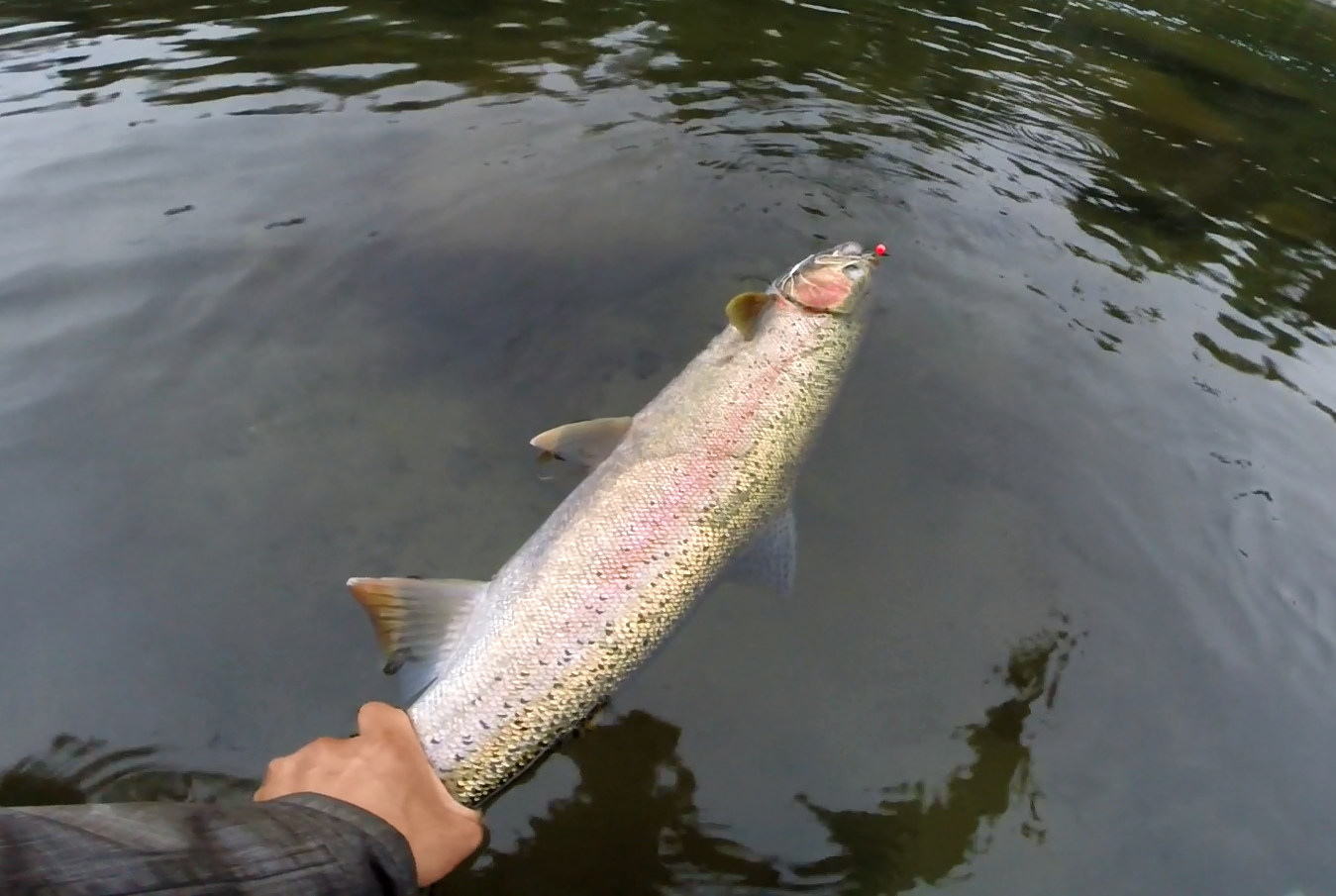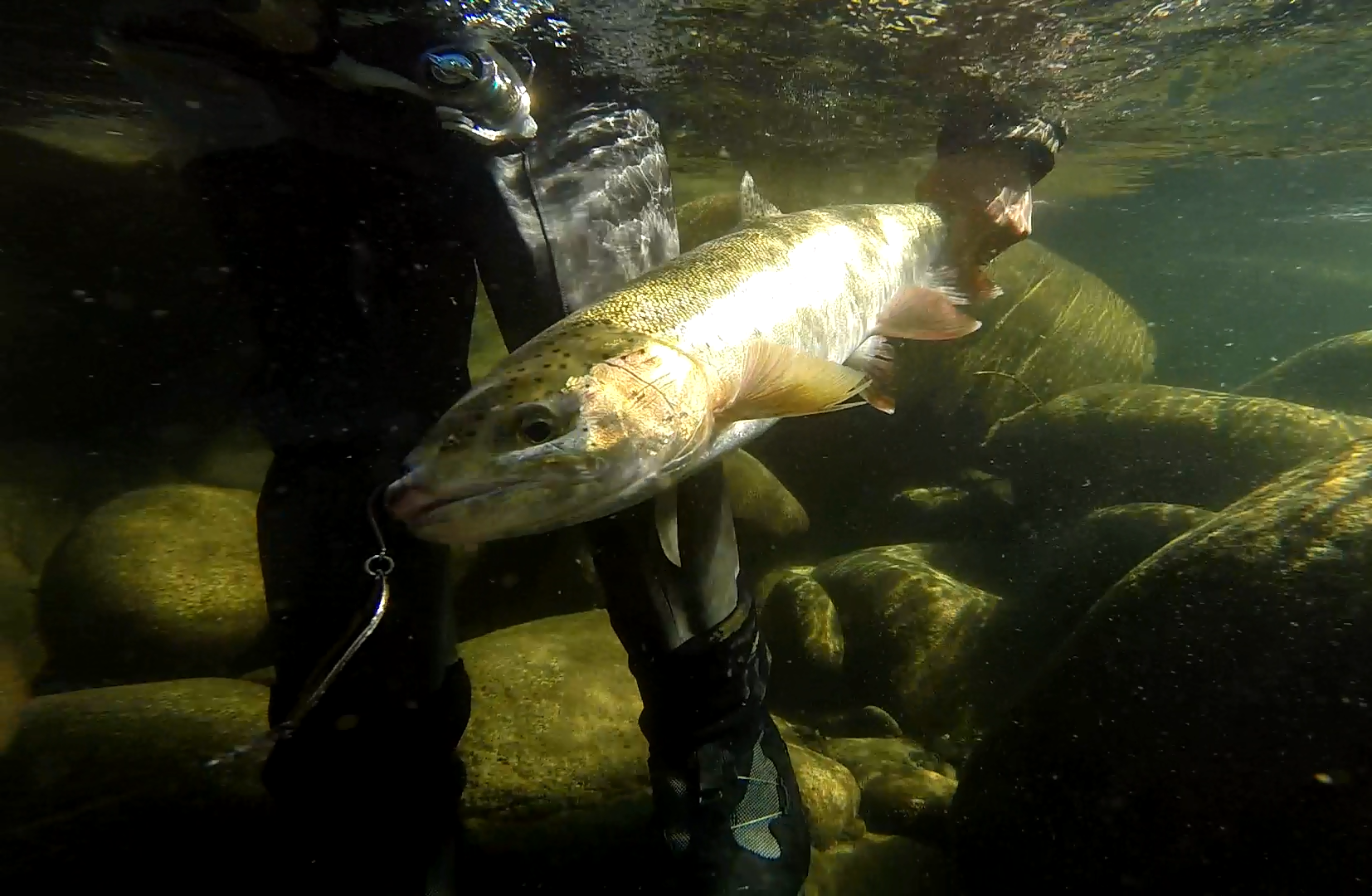Search
Latest Articles
Color Cycling for Steelhead
by Ryan Hung, November 28, 2015

Simplicity at it's finest: a summer buck inhaled this particular trout bead during the first cast of the day.
It's a fact of life: every angler has their kryptonite. For some, it's throwing the same pattern of jig *cough, cough, nightmare*, while others would rather step in a bear trap than switch from roe, perfected in ego-egg-cure 1000, to raw prawn. If I asked "how many of you have seen fishermen tossing the same jig, leader, color and depth for a 4 hour window," many of you wouldn't think twice to raise a hand. Rule number one of steelhead efficacy states the "effective angler openly utilizes color cycling." Be it jigs, yarn balls or beads, one must cycle through colors once the bite subsides, to persuade the seemingly inoperable fish. First, partition the water in front of you into 5 lanes--yes, like a freeway as inefficient as 405, with it's detestable "not good to go" lanes--and brace yourself for bent-rod-greatness. Begin working the lane closest to you, making each subsequent cast one lane farther out. Once you run out of lanes--it should take around 5 minutes to complete, depending on the length of the slot--begin cycling through colors. In the rare event of being unable to persuade one to bite after 25 casts and 5 color cycles, switch your offering type; if you're fishing beads, switch to jigs. If you've been fishing jigs, make certain to have a chunk of salad shrimp firmly affixed at all times. If no such luck avails in the form of chrome-sided olive-backs, it's time to bring out the big guns of nature: bait.

A summer run hen found in want, after color cycling through 5 patterns of jigs
Nothing comes as natural as bait, though many times a steelhead has turned away from what nature has to offer. For example, I've caught more steelhead in high water with beads, than with the world's finest cured roe or prawn. To the winter fisherman, the word "bait" instantaneously associates itself with one of two options: prawns or eggs. Though both highly effective baits, one musn't forget about variety. Thankfully, there are 2 additional baits in your arsenal, existing in the form of nightcrawlers and sand shrimp. Likened to color cycling with jigs, carrying a variety allows the bait fisherman to cycle effectively, to entice fish to bite. And if the fish remain firmly reluctant, the time has come to switch tactics.
If I were permitted but two offerings for the winter steelhead fishery, I would supply myself with boraxed eggs and Mad River pink worms. When fish continually refuse beads, bait and jigs, the time has come to aggravate what's left in the slot. Under the float, the mighty pink worm makes short work of aggressive and lethargic winter fish; they will shimmy a country mile for these. As is paired with efficacy, it will take a maximum of three casts to successfully cover the holding water you're fishing, though one cast is usually sufficient. In the rare event they refuse the pink worm-- something I've never experienced on stacked hatchery fish--you needn't worry, for one final option exists.

Some enjoy jigs, while other enjoy roe; this healthy buck fell for cured roe tossed with Pro-Cure Bloody Tuna scent.
Empirical evidence has shown me that women tend to like things that shine, from earrings and diamond encrusted rings, to necklaces and shoes -- you'd be surprised how many shoes "shine." As women have a proclivity to all things that glisten in light, aggressive steelhead naturally enjoy removing sparkling objects from their territory, with hundreds of needle-like stiletto-teeth lining their jaws. In slack water, trilene knot on a silver-plated spinner and cast it upstream, retrieving it only as fast as necessary to feel the thumping of the # 5 blade chopping through the water; by the end of your first cast, you'll know if a fish was willing, by the absence of your shoulder in socket.

After casting an entire box worth of jigs to no avail, this hen was no match for a #5 purple spinner in gin clear water of the afternoon.
If the school is sitting in front or below your current position, toss out a spoon. After the third cast covering the entire slot, refrain from tossing hardware. If one continues, it will further inhibiting any notion of biting as they will be uncomfortably pacing around in the slot; safety and comfort precede attacking. I was given the name "Spooner," after punching out two catch records worth of Steelhead during my first summer season of angling -- one can only guess what lure I attained proficiency with.

This particular contestant nipped the spoon in a fashion that landed the hook from the outside into the mouth. Courtesy of 2/0 Owner Cutting Point hooks.
If there's something to know about hardware, I've been there many times before, so spend more time catching fish over catching them on what you want them to bite. Remember to K.I.S.S (Keep It Simple Steelheaders). And when due diligence and persistence manifest fish onto the bank, make sure to mark your calendar for next month's article: Salt, Pepper and Magic: How to Smoke World-class Steelhead.
Reel Priorities, out.







